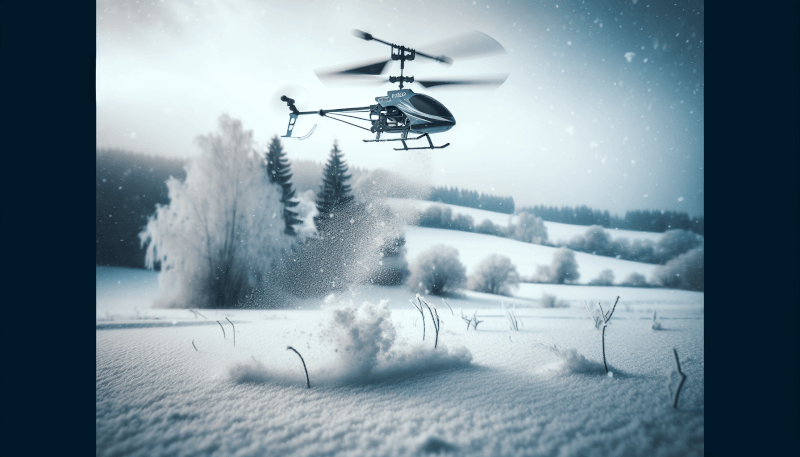Are you ready to conquer the chilly skies with your RC helicopter? In this article, you’ll find a collection of valuable tips and tricks to help you navigate the challenges of flying your RC heli in cold weather. From battery maintenance to adjusting flight controls, we’ll cover everything you need to know to ensure a smooth and enjoyable experience even when the temperature drops. So bundle up, strap in, and get ready to soar through the winter wonderland with confidence!

Preparing Your RC Heli
Checking the Battery
Before taking your RC heli out in cold weather, you need to ensure that the battery is in optimal condition. Cold weather can have a significant impact on the performance of the battery, reducing its capacity and overall flight time. Start by checking the charge level of the battery and ensure it is fully charged. It is also advisable to invest in a battery voltage checker, which will allow you to monitor the voltage while in flight. If the voltage drops too low, it can lead to damage to the battery or even a loss of power mid-flight.
Using Appropriate Lubrication
Lubrication is essential to ensure smooth and efficient operation of your RC heli, especially in cold weather. In lower temperatures, the lubricant can become thicker and less effective. Therefore, it is important to choose a lubricant specifically designed for cold-weather use. Applying the right lubricant to the moving parts of your heli, such as the gears and bearings, will help reduce friction and prevent unnecessary wear and tear.
Preheating the Motor
In extremely cold weather, the motor of your RC heli can struggle to function optimally. A simple solution to this problem is to preheat the motor before starting your flight. This can be done using a hairdryer or a specialized motor heater. By preheating the motor, you ensure that it reaches the optimal temperature for smooth and efficient operation. Be sure to follow the manufacturer’s guidelines on preheating to avoid any damage to the motor.
Securing Loose Parts
Cold weather can cause materials to contract, which may result in parts becoming loose or detached from your RC heli. It is important to inspect your heli thoroughly before each flight to ensure all parts are securely fastened. Pay close attention to screws, bolts, and other connectors, and tighten them if necessary. This simple step can prevent accidents and damage during flight.
Choosing the Right RC Heli
Opting for a Cold-Weather Friendly Model
When choosing an RC heli to fly in cold weather, it is important to select a model that is designed to withstand lower temperatures. Look for helicopters that have been tested and proven to perform well in colder conditions. These models often come with features such as improved insulation and heating systems to ensure optimal performance even in freezing temperatures.
Considering Dual-Rate Controls
Dual-rate controls allow you to adjust the sensitivity of your RC heli’s controls. In cold weather, the responsiveness of your heli may be affected due to the sluggishness caused by the low temperatures. By adjusting the dual-rate controls, you can compensate for this effect and maintain precise control over your heli.
Selecting Proper Rotor Blades
Choosing the right rotor blades for your RC heli is crucial for cold-weather flying. Thicker blades are more resistant to temperature changes and can provide better stability and lift. Look for blades specifically designed for cold weather or opt for carbon fiber blades, which are known for their durability and resistance to temperature fluctuations.
Using a Flybarless System
A flybarless system eliminates the use of traditional stabilizing flybars, resulting in a lighter and more responsive RC heli. This system is particularly beneficial in cold weather as it reduces the susceptibility of the heli to wind and air disturbances. The improved stability and control offered by a flybarless system can help you navigate the cold weather conditions with ease.
Dressing for Success
Layering Properly
When flying your RC heli in cold weather, it is important to dress in layers to regulate your body temperature effectively. Layering allows you to add or remove clothing as needed, providing insulation and flexibility. Start with a moisture-wicking base layer to keep sweat away from your skin. Add a mid-layer for insulation, and finish with an outer shell that is windproof and waterproof. This layering system will help keep you comfortable and protected from the elements.
Protecting Your Hands
Your hands are the most exposed part of your body while flying your RC heli, and they can quickly become cold and numb in cold weather. Invest in a pair of insulated gloves that provide both warmth and dexterity, allowing you to maintain control of your heli’s controls. Look for gloves with touchscreen compatibility, so you can still operate your transmitter without having to remove your gloves.
Wearing Thermal Socks
Cold feet can be a distraction and make flying your RC heli uncomfortable. Wearing thermal socks can help keep your feet warm by providing insulation and moisture-wicking properties. Look for socks made from materials such as merino wool or synthetic fibers designed to retain heat.
Using Insulated Boots
Choosing the right footwear is essential for cold-weather flying. Insulated boots with good traction will keep your feet warm and provide stability on slippery surfaces. Look for boots that are waterproof and have sufficient insulation to protect your feet from the cold. Don’t forget to choose boots that are comfortable and allow for proper circulation to avoid discomfort during flight.
Covering Your Head and Ears
Heat escapes from your head, making it essential to cover it properly in cold weather. Wear a warm hat or beanie that covers your ears and provides insulation. This will help retain body heat and keep you comfortable during your flights.
Using Thermal Undergarments
Thermal undergarments provide an extra layer of insulation, helping to keep your core warm. Look for long-sleeved tops and long johns made from materials such as merino wool or synthetic fibers designed to trap heat while wicking away moisture. This additional layer of warmth will keep you comfortable during your cold weather flying sessions.
Taking Off in Cold Weather
Checking Weather Conditions
Before taking off in cold weather, it is crucial to check the weather conditions. Extreme cold, strong winds, or heavy snowfall can pose risks to both you and your RC heli. Ensure that the conditions are suitable for flying and adjust your flight plans accordingly. Monitoring weather forecasts and staying up to date with any weather warnings in your area will help you make informed decisions about when and where to fly.
Clearing Snow/Ice from the Takeoff Spot
A clear and unobstructed takeoff spot is essential for a safe flight. Before starting your RC heli, make sure to clear any snow or ice from the area where you plan to take off. This will prevent any debris from getting caught in the rotor blades or causing instability during takeoff. Use a snowbrush or shovel to clear the area thoroughly.
Planning for Reduced Flight Times
It is important to keep in mind that cold weather can significantly reduce the flight time of your RC heli. The cold temperatures affect the battery life, motor performance, and overall efficiency of the heli. Be aware of this and plan your flights accordingly. Consider shorter flight durations and have spare batteries on hand for extended flying sessions.
Pre-Warming the Engine
Similar to preheating the motor, pre-warming the engine of your RC heli can improve its performance in cold weather. Using a hairdryer or a specialized engine pre-heater, gently warm the engine before starting your flight. This helps the engine reach its optimal operating temperature faster and ensures smooth and reliable performance throughout your flight.
Using Warm Air Intakes
In cold weather, it can be challenging to maintain the temperature inside your RC heli. One effective way to counteract this is by installing warm air intakes. These devices direct warm air from the engine or other heat sources to the critical components of your heli, such as the electronics and battery compartment. This helps maintain the internal temperature, preventing any adverse effects caused by the cold weather.
Avoiding Foggy Goggles
Foggy goggles can obstruct your vision and make flying your RC heli dangerous. To prevent fogging, consider using anti-fog wipes or sprays specially designed for goggles. Another effective method is to apply a small amount of baby shampoo or dish soap diluted with water to the lenses. This creates a thin film that prevents fogging. Be sure to rinse and dry the goggles thoroughly before use.

Taking Care of Batteries
Keeping Batteries Warm
Cold temperatures can significantly impact the performance of your RC heli’s batteries. To ensure optimal battery performance, it is essential to keep them warm before and during flight. Store your batteries in a warm location before heading out to the flying site. Consider using a portable battery warmer or insulation pouch to maintain the battery temperature during flight.
Using Battery Insulators
Battery insulators are designed to provide insulation and protection to your RC heli’s batteries. These insulators are typically made of neoprene or other insulating materials and enclose the batteries, shielding them from the cold. Investing in battery insulators can help maintain the battery temperature and extend their overall lifespan.
Monitoring Battery Voltage
Monitoring the battery voltage while in flight is crucial, especially in cold weather conditions. Cold temperatures can diminish battery performance, leading to a sudden drop in voltage and potentially causing a loss of power mid-flight. To avoid this, use a battery voltage checker or telemetry system to monitor the battery voltage in real-time. If the voltage drops too low, it’s time to land and replace the battery.
Using a Battery Warmer
A battery warmer is a specialized device designed to maintain the warmth of your RC heli’s batteries. These warmers use adjustable heating elements to provide a constant and optimal temperature for the batteries, improving their performance and overall lifespan. Battery warmers also come in various sizes, allowing you to warm multiple batteries simultaneously.
Rotating Batteries
To maximize the lifespan and performance of your RC heli’s batteries, it is advisable to rotate them during flight sessions. Cold temperatures can have a more significant impact on batteries that have been left inactive for extended periods. By rotating your batteries during flight, you ensure that all batteries receive equal usage, reducing the risk of deterioration due to cold weather conditions.
Managing Electronics and Controls
Ensure Connection Integrity
Before taking off in cold weather, it is essential to ensure the integrity of all electrical connections in your RC heli. Inspect the wiring, connectors, and solder joints to ensure they are secure and undamaged. Loose connections can lead to malfunctioning electronics and control issues, posing a risk to your flight. Take the time to thoroughly check all connections and address any issues before taking off.
Secure Electrical Connections
Cold weather can cause materials to contract, potentially loosening or compromising electrical connections in your RC heli. It is crucial to secure these connections to prevent any malfunctions due to loose wiring. Consider using cable ties, electrical tape, or heat shrink tubing to secure the connections and protect them from the elements.
Protecting Electronic Components
Electronics are highly sensitive to cold temperatures and can malfunction or fail in extreme conditions. To protect your RC heli’s electronic components, invest in a protective casing or enclosure. These casings provide insulation and add an extra layer of protection against cold weather and moisture.
Using Cold-Weather Resistant Servos
Servos are critical components of your RC heli’s control system. In cold weather, the performance of servos can be compromised due to the low temperatures. Cold-weather resistant servos are specifically designed to operate in lower temperatures, ensuring reliable control during your flights. Consider investing in these servos to avoid any potential issues caused by cold weather conditions.
Using a Water Repellent Coating
Water repellent coatings are designed to protect electronic components from moisture and water damage. In cold weather, snow and ice can melt, potentially exposing your RC heli to water and causing damage. Apply a water repellent coating to your heli’s electronics and control systems to create a protective barrier against moisture and ensure their longevity.
Performing Control Checks
Before taking off in cold weather, it is crucial to perform thorough control checks to ensure the proper functioning of your RC heli. Test all control inputs, including the throttle, elevator, aileron, and rudder. Pay close attention to any sluggishness or unresponsiveness caused by the cold temperatures. Make any necessary adjustments or repairs before flight to ensure a safe and enjoyable experience.

Avoiding Moisture and Water Damage
Avoiding Winter Precipitation
Flying your RC heli in winter conditions may expose it to snow, sleet, or freezing rain. Whenever possible, avoid flying in such conditions to minimize the risk of moisture and water damage. Keep a close eye on weather forecasts and plan your flights accordingly.
Using Protective Covers
Protective covers are essential for safeguarding your RC heli from moisture and water damage in cold weather. They are typically made of waterproof and durable materials that shield your heli’s sensitive components from snow, ice, and rain. Invest in a high-quality protective cover that fits your heli securely, ensuring maximum protection during storage and transportation.
Drying the RC Heli Post-Flight
After flying in cold weather, it is crucial to dry your RC heli thoroughly. Moisture can accumulate on the heli’s surface, leading to corrosion and damage to crucial components. Use a soft towel or cloth to carefully remove any moisture or snow from the heli. Pay close attention to hard-to-reach areas and ensure that all parts are dry before storing the heli.
Using Waterproof Electronics
Investing in waterproof electronic components for your RC heli is an excellent way to protect it from moisture and water damage. Waterproof servos, receivers, and speed controllers are specifically designed to withstand exposure to water without compromising performance. When flying in wet or snowy conditions, having waterproof electronics will provide additional peace of mind and extend the lifespan of your RC heli.
Storing Helicopter in a Dry Environment
After flying your RC heli in cold weather, it is crucial to store it in a dry environment. Moisture can accumulate on the heli’s components, even if it doesn’t come into direct contact with water. To prevent any moisture-related damage, store your heli in a designated storage case or a dry and well-ventilated area. Avoid storing it in damp basements or garages where moisture levels may be high.
Maintaining Optimal Performance
Avoiding Flight in Extreme Cold
While it may be tempting to fly your RC heli in extremely cold temperatures, it is generally not recommended. Severe cold can negatively affect the performance of your heli’s components, leading to malfunctions or even failures. It is important to check the operating temperature range specified by the manufacturer and avoid flying outside of that range to ensure the optimal performance and longevity of your RC heli.
Monitoring Temperature Changes
When flying your RC heli in cold weather, it is essential to monitor any significant temperature changes throughout your flight. Sudden drops or fluctuations in temperature can affect the performance of your heli’s components and cause unexpected behavior. If you notice any unusual behavior or problems that coincide with temperature changes, it is advisable to land your heli and investigate further before continuing your flight.
Performing Regular Maintenance
Regular maintenance is vital for ensuring the optimal performance and longevity of your RC heli, especially in cold weather conditions. After each flight, take the time to inspect your heli thoroughly, checking for any signs of wear or damage. Clean your heli and lubricate the moving parts as needed. Regularly replace worn-out or damaged components to maintain reliable performance and avoid potential accidents.
Cleaning after Flights
Flying your RC heli in cold weather conditions can expose it to dirt, snow, and debris. After each flight, take the time to clean your heli to remove any dirt and grime that may have accumulated. Use a soft brush or compressed air to clean hard-to-reach areas and ensure that all moving parts are free from debris. Regular cleaning will not only keep your heli looking its best but also help maintain its performance and extend its lifespan.

Flight Safety in Cold Weather
Avoiding Frozen Bodies of Water
When flying your RC heli in cold weather, it is crucial to avoid flying over frozen bodies of water. The thickness of the ice can be uncertain, and flying over it poses a significant risk of the heli crashing through the ice. This can not only lead to the loss of your RC heli but also create a dangerous situation if you need to retrieve it from the water.
Maintaining Visual Line of Sight
Maintaining visual line of sight with your RC heli is crucial for flight safety, especially in cold weather conditions. Snowfall, fog, and low visibility can make it challenging to see and track your heli’s movements. It is important to fly within your visual range and avoid flying too high or too far away, where it becomes difficult to see and control your heli effectively.
Using High-Visibility Colors
Using high-visibility colors on your RC heli is an excellent way to enhance visibility, especially in snowy or overcast conditions. Bright colors such as red, orange, or yellow make your heli more noticeable against the white or gray background. Consider using colored decals, tape, or paint to increase the visibility of your heli, making it easier to track and control during flights.
Keeping Emergency Supplies
When flying your RC heli in cold weather, it is always a good idea to have emergency supplies on hand. Pack a small emergency kit that includes essential items such as a first aid kit, spare batteries, basic tools, and extra clothing. In the event of an unexpected situation or extended flight, these supplies will ensure your safety and comfort while you address any issues.
Recovering from a Crash
Locating the RC Heli
If your RC heli crashes in cold weather, locating it quickly is crucial. Fresh snowfall can bury your heli, making it difficult to find. Use a long object, such as a broom or a ski pole, to probe the snow and find the location of your heli. Alternatively, attach a small GPS tracker to your heli for easy retrieval in case of a crash.
Avoiding Fuel Leakage
If your RC heli crashes, there is a risk of fuel leakage, especially if using a nitro-powered model. Fuel spills can be dangerous and pose a fire hazard. If you suspect fuel leakage, avoid touching the heli and carefully assess the situation. If necessary, use an absorbent material, such as sand or kitty litter, to contain and absorb the spilled fuel. Take proper precautions and dispose of the contaminated material safely.
Inspecting for Damages
After a crash, it is crucial to inspect your RC heli for any damages. Check the frame, rotor blades, electronics, and other components for signs of wear or breakage. Carefully assess the extent of the damage and make repairs or replacements as necessary. It is recommended to consult the manufacturer’s guidelines or seek professional assistance for repairing any significant damages.
Handling Battery Safely
If your RC heli crashes, take extra precautions when handling the battery. Damaged batteries can pose a risk of fire or other hazards. If the battery is visibly damaged or swollen, do not touch it and carefully remove it from your heli using non-conductive gloves or tools. Store the damaged battery in a fireproof container and dispose of it properly following local regulations.
Flying your RC heli in cold weather can be an exhilarating experience, but it also comes with unique challenges. By following these tips and tricks, you can ensure a safe and enjoyable flight experience while protecting your RC heli and maximizing its performance in cold weather conditions. Remember to always prioritize safety, monitor weather conditions, and thoroughly prepare yourself and your heli before taking to the skies in the cold. Enjoy your winter flying adventures!



